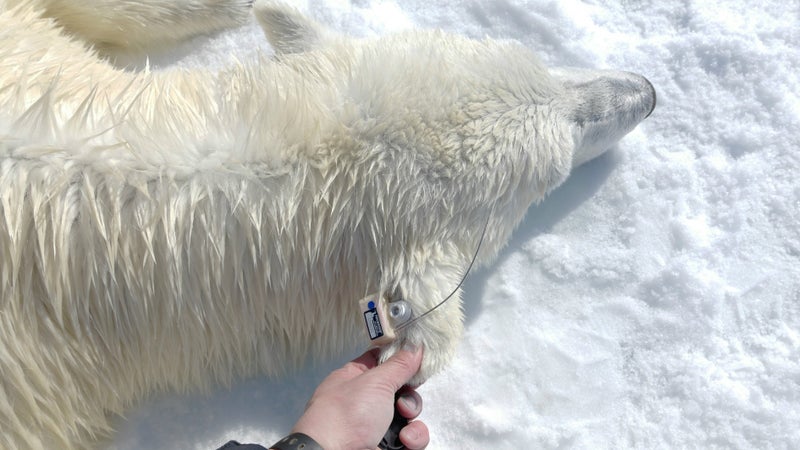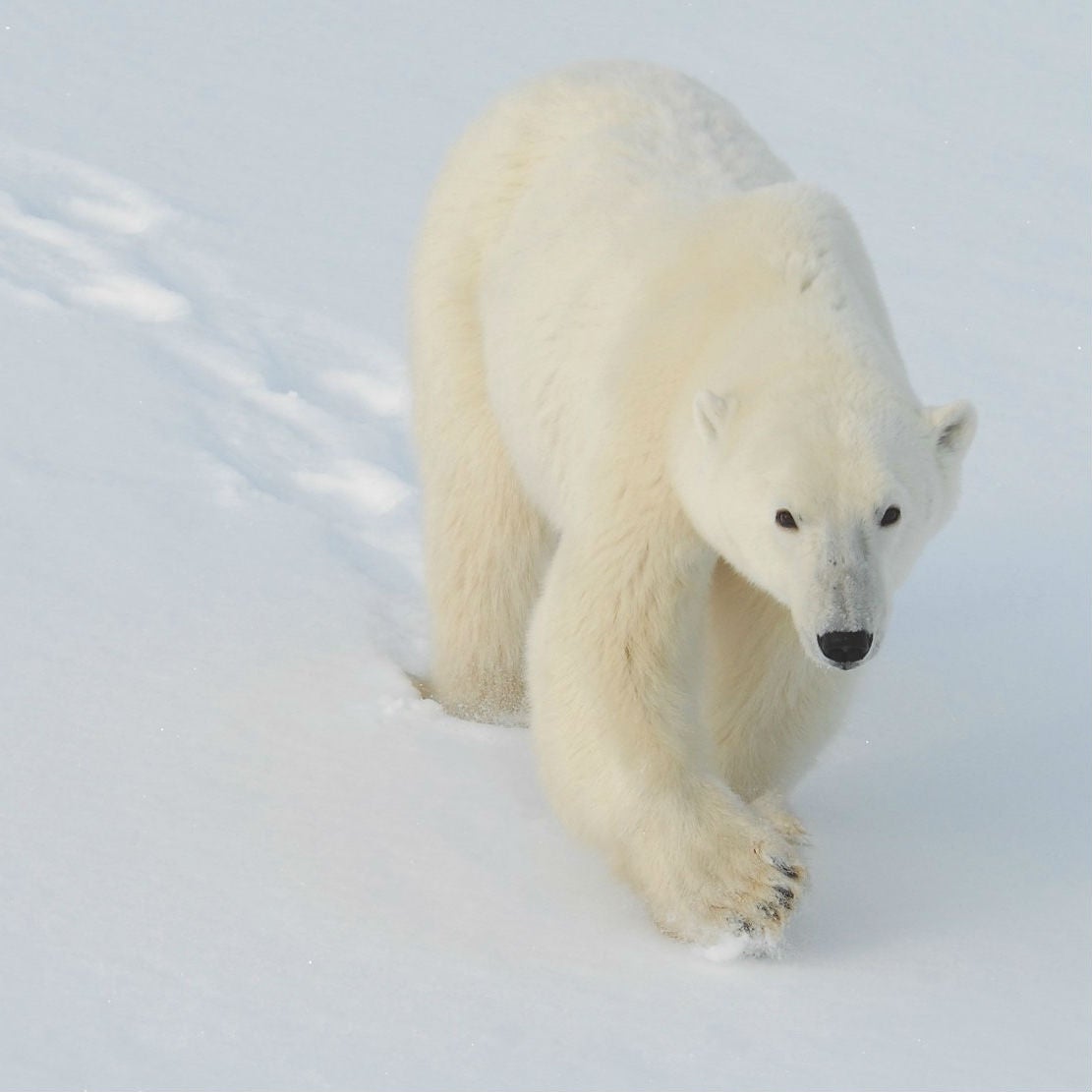More than any other keystone species, the polar bear is directly threatened by climate change. So the goal of conservationists is to try to keep their numbers high enough over the coming decades that we may still have a viable population when, or if, sea ice levels can be returned to normal. The latest solutions in that fight? Jails and radar stations. 
To recap, polar bears survive by hunting seals on frozen sea ice above the arctic circle. But as that area of ice and the portion of the year when it remains frozen both continue to shrink, the bears find it harder to hunt. This is causing their numbers to plummet, while conflicts between bears and humans increase, which can reduce their numbers even further. 
The Western Hudson Bay populationÔÇöone of 19 worldwideÔÇöhas seen its numbers fall from about 1,200 in 1998┬áto . Those are the bears that gather every fall near Churchill, Manitoba, waiting for the ice to reform so they can return to sea. There, a town of 900 hosts 10,000 visitors who come to see that migration. But as bears must wait longer for the┬ásea ice, theyÔÇÖre motivated to seek out alternative food sources in town. And that leads to trouble.┬á
ÔÇťThe population is decreasing, but conflict is increasing,ÔÇŁ says Andrew Derocher, a scientific adviser to . ÔÇťThis seemingly contradictory scenario is entirely consistent with nutritionally stressed bears spending longer periods of time on shore.ÔÇŁ┬á
Traditionally, the method for reducing conflicts between bears and humans┬áwas simply to kill more bears. And the annual quota of bears that the Inuit hunters in nearby Nunavut, which shares the same bear population, are able to take is a hotly debated topic. As polar bears become more stressed by decreasing access to sea ice, itÔÇÖs also becoming less certain that hunting them has a meaningful impact on conflict, all while bringing that population closer to the brink. So experts are looking for new solutions.┬á
One of those solutions is polar bear jail. In Churchill, bears that enter town in search of food are sent to the slammer, where theyÔÇÖre held in cages with minimal interaction and without food until the sea ice starts to reform┬áand the bears┬ácan once again hunt seals. Then theyÔÇÖre transported by helicopter northward, onto the sea.┬á
ÔÇťThe idea is to not reward their behavior┬ábut to discourage it,ÔÇŁ Derocher says. The bears typically fast throughout the summer anyway, and by keeping them safe until they can hunt for food, wildlife management officials are making sure they donÔÇÖt reinforce any connection between humans and food sources.┬á

The problem was┬áthat, until 2017, it was hard to convince residents that the program was effective. WouldnÔÇÖt hungry bears transported a short distance northward┬ásimply enter other towns for food instead? Existing tracking technology relied on bulky GPS collars that could be fitted only to male bearsÔÇöfemale heads arenÔÇÖt big enough to prevent the collars┬áfrom slipping off. A smaller ear-tag tracking device was later developed that could be used on any bear. Derocher says itÔÇÖs too soon to draw definitive conclusions, but early signs indicate that the program is successful: Bailed-out bears are returning to the sea ice as intended, rather than continuing to pester human settlements.┬á
But a successful polar bear jail means having to find┬áthose bears before they can enter town┬áand create a connection between humans, the places they live, and tasty stuff to eat. Until 2018, early detection of bears relied on human patrols. With growing nutritional stress due to the increased loss of sea ice, the number of bears attempting to enter Churchill was getting out of controlÔÇö2016 saw 300 bear response calls┬áin a town that numbers just 900 people. A better means of detectionÔÇöand one that would work at night┬áor in adverse weather conditionsÔÇöwas needed. Enter radar.┬á
Like GPS tags, radar is another technology thatÔÇÖs become drastically smaller and more affordable in recent years. , a Utah-based defense contractor, makes small, portable ground radar units intended to detect human intruders around sensitive places┬álike power plants┬áand data centers. The radar units themselves are about the size of a telephone book, and prices start at about $30,000. With the help of Salt Lake CityÔÇÖs Hogle ZooÔÇöfamous for its underwater polar bear viewingÔÇöPolar Bears International was able to raise the funds necessary to install a bear-monitoring radar unit on the roof of the townÔÇÖs community center.┬á
Detecting bears approaching across the tundra requires teaching the software that runs the radar to learn the difference between, say, a human riding an ATV and a large predatory mammal. The software can learn to dismiss fixed objects like rocks and can be taught to recognize the size and movement patterns of different animals. Polar Bears International is able to monitor these functions remotely from its office in Bozeman, Montana, where it compares them against security camera footage and is slowly training false positives out of the system. Meanwhile, bears that are detected approaching town can be scared off with nonlethal deterrents or, if they persist, captured and thrown in jail. 
The goal isnÔÇÖt simply┬áto reduce conflict between bears and humans around Churchill, but to develop systems and practices that can be employed by other communities throughout the arctic. The bear-detecting radar, in particular, holds promise for smaller communities that canÔÇÖt afford a full-time bear patrol. The hope is that human-bear conflict can become more manageable, even as climate change is causing hungrier bears to spend more time on shore. And providing communities across the arctic with the ability to manage that conflict with nonlethal means may┬áreduce the number of bears the communities kill. Later this century, if we are able to take meaningful action on climate change, these technologies could help ensure that we have enough polar bears left to repopulate the arctic.┬á
ÔÇťScience canÔÇÖt save polar bears, but it can help both the people and the bears find a way to smooth out their relationship in a changing arctic,ÔÇŁ Derocher says. ÔÇťWe owe it to the people who live day to day with polar bears, and the bears themselves, to find smarter ways to coexist.ÔÇŁ


